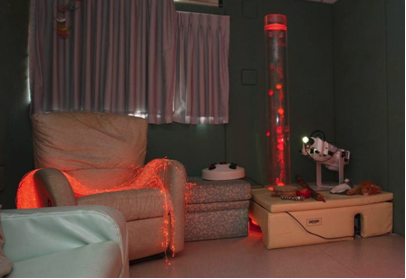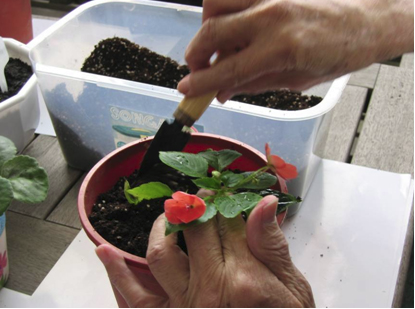Aims:
Improve emotional state and social skills; stimulate cognitive functioning, motor functioning and hand-eye coordination; and raise self-esteem and satisfaction level.
Methods:
Listening to music, movement to music, lyric analysis or discussion, singing or playing instruments, expressing feelings and instrumental improvisations, etc.
How to do it at home:
-
Materials:
- Simple musical instruments such as glockenspiel, tambourine and maracas.
- Music such as CDs, records.
-
Steps:
- Listen to a song the person likes or is familiar with.
- Talk about the singer, when the song was released, how the person feels about the song, etc.
- Play along with simple musical instruments, or even sing along at the same time.
- Encourage the person to express his or her feeling with the instruments.
- Listen to the same relaxing music or song every time as the closure.
Aims:
Relaxation, mood improvement and reduction of behavioural symptoms with the use of 100% natural essential oils.
Methods:
Put a few drops of essential oil or diluted essential oil on a diffuser to facilitate evaporation, massage with diluted essential oils, blend diluted essential oils with body lotion and apply them to the skin, etc.
How to do it at home:
-
Materials:
- 100% natural essential oils such as lemon balm, lavender, chamomile, bergamot, neroli, or valerian oil.
-
Steps:
- Put a few drops of essential oil or diluted essential oil on a diffuser and let the scent spread.
- Help the person to relax more by giving him or her a massage. The best time to give a massage is between 3 p.m. and 4 p.m.
Remarks:
- Some people may feel sick after smelling strong scents. The majority of essential oils will cause irritation if applied to the skin directly. The dilution rate is different for different essential oils for different purposes. Use of essential oils may be fatal for some patients with specific health conditions. Please consult an aromatherapist before purchase and usage.
- Ingestion of essential oils can be fatal. Please store essential oils in a safe place and keep them out of the person's reach.
- Electric aromatherapy diffusers and aromatherapy nebulizing diffusers can prevent accidental fires.
Aims:
Relaxation and reduction of behavioural symptoms by stimulating the five senses.
Methods:
Stimulate the sense of sight with an effects projector, a coloured fibre-optic spray, a bubble column, etc. Stimulate the sense of hearing with music, musical instruments, a bubble column, etc. Stimulate the sense of touch with a vibrating mattress, a weighted blanket, a bubble blower, materials with different textures, etc. Stimulate the senses of smell and taste with aromas, materials with smells and tastes, etc.

How to do it at home:
-
Materials:
- Sensory devices of sight: Home planetarium, effects projector.
- Sensory devices of hearing: Relaxing music, nature sounds.
- Sensory devices of touch: Plush toys, soft and comfortable sweaters, imitation animal skins.
- Sensory devices of smell and taste: Fruits, flowers.
-
Steps:
- Keep the environment quiet and comfortable.
- Display and guide the person to discover and experience sensory devices one by one.
- Observe the reaction of the person and encourage the person to be expressive and communicate.
Aims:
Maximize concentration, attention, memorization, cognitive functions, upper-extremity motor activity and hand-eye coordination; improve social skills, promote positive thinking, raise self-esteem and satisfaction level.
Methods:
Enjoy looking at plants and gardens, planting different plants, discussing the family and genus of a plant, drying flowers, sharing, and discussions.

How to do it at home:
-
Materials:
- Seeds, potting soil, pots, shovel, gloves, etc.
-
Steps:
- Pick a theme, look at related plants and talk about it.
- Introduce the plant the person will be planting.
- Demonstrate and guide the person to prepare the soil, plant the seeds, water the plant, etc.
- Share and discuss the feeling of planting and watching the plant to grow.
Remarks:
- Please choose a type that is easy to grow according to the season to avoid withering, and plant multiple pots in case the seed the person planted does not sprout.
Aims:
Maximize attention, upper-extremity motor activity, lower-extremity motor activity, body balance, muscle strength, etc.
Methods:
Gentle physical movements, home-based training program, physiotherapy, etc.
How to do it at home:
Please consult a physiotherapist.
Aims:
Maximize home care and community living skills, concentration, attention and hand-eye coordination through improving occupational performance; improve self-esteem.
Methods:
Demonstrate and guide the person to practice the steps of self-care, homemaking, etc.
How to do it at home:
Please consult an occupational therapist.
Aims:
Maximize language functioning and emotional control through social interactions and activities; create joyful moments.
Methods:
Chat with people the person likes, attend family gatherings, participate in outdoor activities, etc.
How to do it at home:
- Talk about happy memories.
- Invite family members and friends to visit the person and have little chats.
- Practice cognitive training and various therapies, and massage the person.
- Please consult a speech therapist for issues around swallowing.